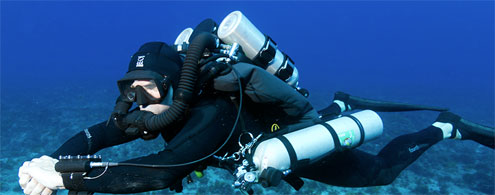Rebreathers

The Scuba Doctor is on the cutting edge of rebreather technology. We sell, maintain, service and repair the the KISS Rebreather range of closed-circuit rebreathers.
And, of course, we train divers to use these rebreathers. Our rebreather training includes over 20 hours of practical academic training, hours of pool sessions, and at least 8 open water dives.
Why all the training? Our goal is to have you "over-learn" the basics so you are completely comfortable with your rebreather. We go over and above the minimum training standards required by the certifying authorities.
KISS Rebreathers
Most will recognise that KISS is the acronym for "Keep it simple stupid."
KISS is an acronym first coined by Kelly Johnson, of the Lockheed Skunk Works, creators of the famous U-2 and SR-71 Blackbird spy planes. The idea was not to imply that the engineers he was working with were stupid, but just the opposite in that his belief for most systems to work best in the field under real-world conditions, their design should be kept as simple as possible instead of complex.
The concept goes even further back to one of histories most renowned inventors, Leonardo da Vinci, who emphasized "Simplicity is the ultimate sophistication," noting that the ultimate goal in design should be the avoidance of unnecessary complexity.
This was a key philosophy for Gordon Smith, a tool and die maker who adopted the acronym and created the first KISS rebreathers in 1995. The most reliable machines are those that are straightforward, easy to use, and easy to repair, regardless of what function they are meant to perform. When designing a machine that is meant to go underwater and that is life support equipment, KISS Rebreathers feels that it is especially important to follow the keep it simple philosophy. It's important to remember that everything eventually fails, and this is certainly true for any product that is taken underwater.
Since then, KISS Rebreathers has kept true to this philosophy and the core design of their initial rebreather. KISS Rebreathers continue to innovate and have some of the smallest, most inexpensive rebreathers on the market today, perfect for the traveling rebreather diver.
Each KISS Rebreather comes with a variety of PO2 monitoring options, as well as accessories.
Choosing A Rebreather
One of the biggest issues we see in the CCR world today is the bias of certain vendors and instructor to push a particular product, as it's the only one they teach on or sell. All rebreathers have their strengths and weaknesses, and there is no 'perfect' rebreather, and we strongly disagree with some seller's practices of slandering units they don't teach or sell.
You won't find that bias here at The Scuba Doctor. Our staff are certified to dive and teach a variety of rebreathers. As a result we don't have an agenda to push on you. Have questions? One of our staff can give unbiased, review, including the pros and cons of all the major units on the market today.
Benefits of Diving a Rebreather
Wondering whether rebreathers are the next logical step for you? We've set up this guide to help you decide.
Longer Bottom Time
Imagine diving for 60 minutes at 100 feet with no decompression time. Or 90 minutes at 65 feet. Or two hours or even four hours at shallower depths. Rebreathers reduce the nitrogen out of the air you breathe, reducing significantly your nitrogen load that leads to decompression diving, longer surface intervals, and, at worst, decompression sickness.
Silent Diving
Your exhaled gas isn't released into the surrounding water. This means you aren't venting bubbles. Loud bubbles. Clouds of bubbles.
This means you are diving silently. That silence, and the lack of scary random bubble clouds, allows you to get eye to eye with shy marine life that would usually hide upon hearing you. Most professional dive photographers are using rebreathers.
No Bubbles
Because your exhaled gas isn't released into the surrounding water, you make no bubbles. No noisy bubbles. No clouds of bubbles to get in your viewfinder while you snap a picture of that elusive splendid toad fish. In other words: no holding your breath while you wait for that fish to just stop spinning so you can take its picture.
Additional Warmth while Diving
The air you breathe with a rebreather is warm and moist, rather than cold and dry on open circuit. This keeps you warmer throughout your dive (your body doesn't have to expend energy to heat the air you breathe) and prevents dry cotton mouth.
Less Weight to Carry Around
Because a rebreather replaces the standard scuba cylinder and BC, it is often much lighter than a typical open circuit setup.
Reliabilty
The Scuba Doctor only offers rebreathers with a proven safety track record. We only offer rebreathers that are built by companies with excellent long-term reputations.
Fun!
You really can interact with more underwater critters because you're diving truly silent.

